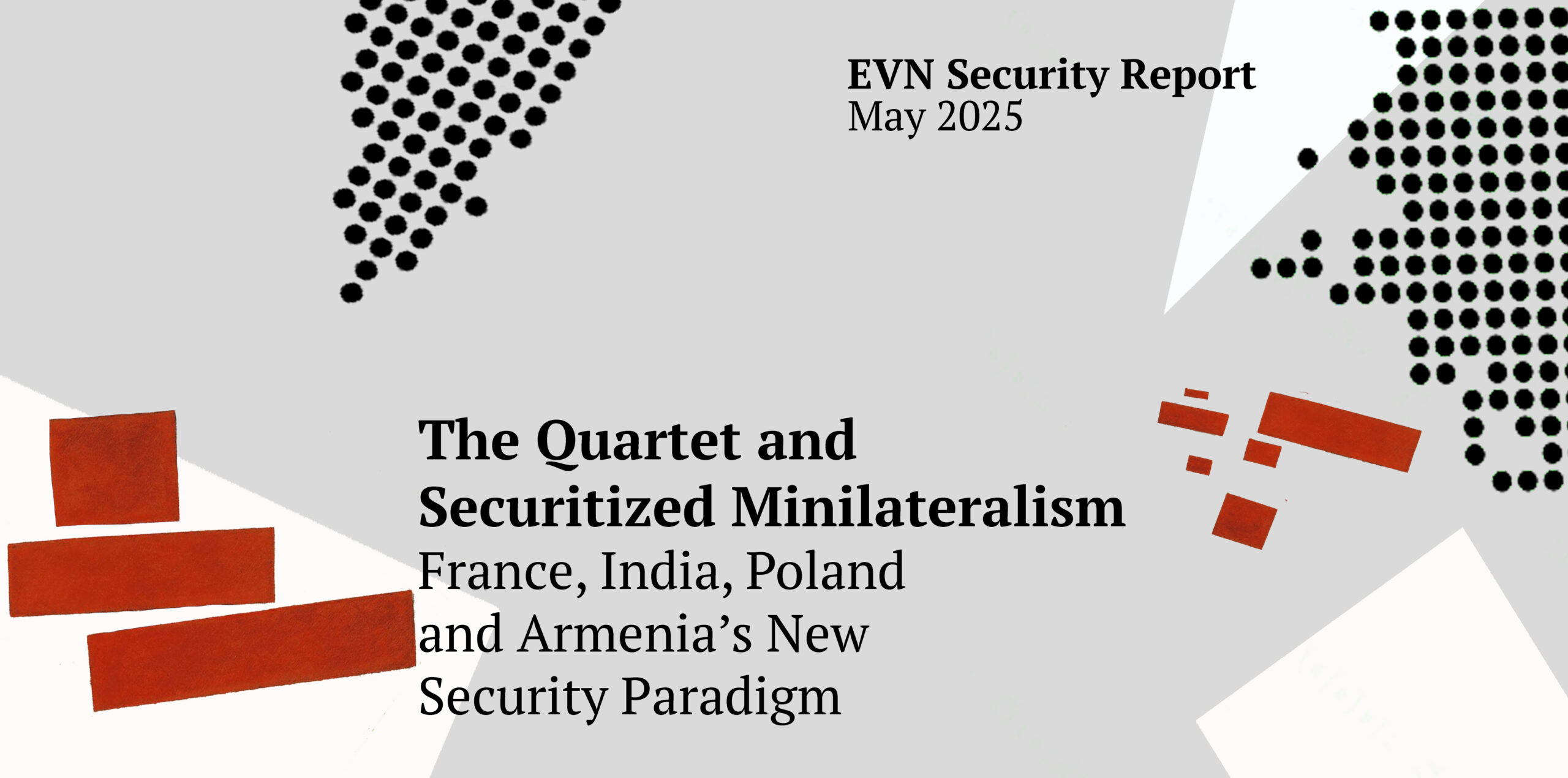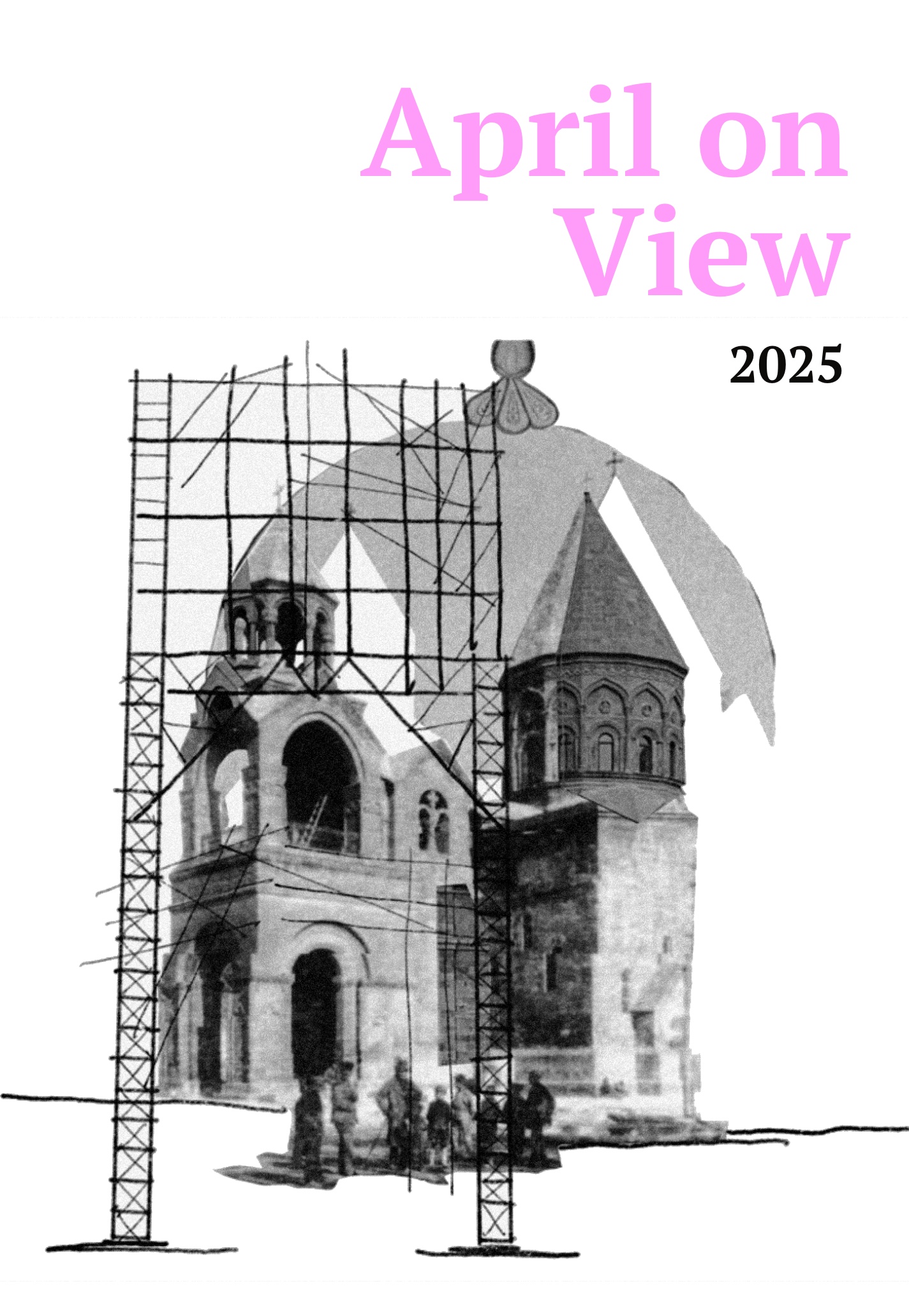
Listen to the EVN Security Report.
Armenia hosted the second Yerevan Dialogue, in partnership with India, Poland and France from May 26 to May 27. While the Yerevan Dialogue serves to expand Armenian soft power by projecting its growing diplomatic capital and international visibility, the conceptual symbolism of these four countries working together carries deeper strategic weight. By supporting Armenia’s regional interests, and immersing themselves into this endeavor, each of these states is also advancing their own strategic goals. This convergence has created fertile ground to pose a concrete question, and subsequently, a concrete course of action: on what mutually beneficial basis can all four of these countries come together to form a set of security arrangements? And what would an alliance of this quartet look like for Armenia’s security architecture?
When initially triangulating the set of configurations informing the relationships between these four countries, what stands is a matrix of bilateral relations and a continuum on the scope and depth of such relations. In this context, Armenia-French and Armenia-India relations are strategically deep with growing security arrangements, while Franco-Indian and Franco-Polish relations are equally robust with wide-ranging and expansive security engagements. India-Polish relations and Armenia-Polish relations, while comparatively not as strongly developed as the other set of bilateral relations in the matrix, nonetheless demonstrate important promises of growth and deepening of strategic interests. The confluence of these sets of bilateral relationships and the endeavor of reconfiguring these separate sets of engagements into a singular minilateral arrangement provides the basis for establishing a quartet alliance. The preferred conceptual framework to articulate this arrangement is the concept of minilateralism, sometimes referred to as “loose multilateralism.” To qualify it within Armenia’s security architecture, this report introduces the concept of securitized minilateralism.
Minilateralism entails the “bringing together of the smallest possible number of countries needed to have the largest possible impact on solving a particular problem” or set of problems. Minilateralism is driven by a group of countries pursuing shared interests to advance collective action in the face of failures or problems in regional or transnational governance. The extant scholarship demonstrates that minilateral groupings serve as foundational basis for multilateral progress, as such arrangements offer flexibility, speed and innovative approaches to addressing the problem(s) at hand. Minilateralism emphasizes shared interests instead of shared values or ideological alignment. While the latter two characteristics can support and strengthen the minilateral arrangement, the primary and underlying factor, however, remains the mutually reinforcing strategic interests of the actors involved. The Quadrilateral Security Dialogue (U.S., Japan, India and Australia), I2U2 (India, Israel, U.S. and UAE), Negev Forum (U.S., Israel, Egypt, Morocco, UAE and Bahrain), and Abraham Accords are all examples of minilateralism designed to strengthen regional cooperation, while incorporating important security components.
What is the nature and scope of the numerous bilateral relationships within the matrix of these four countries and how can these be reconfigured into a minilateral structure?
France and Poland signed the Nancy Treaty in May 2025, formalizing and deepening relations between the two countries within the domain of security that is akin to the treaties signed by France with Germany (Aachane Treaty), Spain (Barcelona Treaty), and Italy (Quirinal Treaty). The elevation of Franco-Polish relations within this sphere, and its equivalence to what France has with its Western European allies, demonstrates the scope and depth of the partnership. For Warsaw, the treaty strengthens Poland’s influence within the EU and NATO by “deepening bilateral partnerships with influential member states” and also diversifying “its security guarantees” as part of the transatlantic system. The Nancy Treaty expresses the intentions of both countries to strengthen European security through the need for Europe to take greater responsibility for its own defense and deterrence capabilities. The Treaty also entails mutual security guarantees, with each side coming to the aid of the other in cases of aggression. Further, the treaty seeks to institutionalize and strengthen cooperation in development of weapons production and military technological capabilities. In this totality, while both are members of NATO and the EU, the Nancy Treaty further deepens the integration of each country into the security architecture of the other.
While Franco-Indian defense and technological cooperation have proven exceedingly fruitful for India’s ability to develop an indigenous military industrial complex, India-French relations, however, reached new heights with Prime Minister Modi’s visit to Paris in February 2025, as the two countries reached agreements within their strategic partnership on defense, AI, nuclear energy, and Indo-Pacific cooperation. Joint defense collaboration in the fields of submarine and missiles production, joint production of helicopters and fighter jets, as well as French interests in integrating Indian weapons systems, such as the Pinaka MBRL, into the French arsenal, defined the terms of the deepening of defense ties between the countries. Both countries also have addressed the importance of collaborating on regional security matters, especially the India-Middle East-Europe Corridor (IMEC), as well as undertaking joint military exercises and strategic alignment in the Indo-Pacific, with specific intentions of containing China’s growing interests in the region.
Poland-India relations were upgraded to that of a strategic partnership after Prime Minister Modi’s landmark visit to Poland in August 2024. The developing relations between the two countries entails mutual interest in regional security cooperation, trade and investment, and strengthening cyber security. An important objective for Warsaw is to deepen its cooperation with India in the defense industry sector, noting India’s rapid modernization of its armed forces and its methodical pivot away from Russia as its main weapon’s supplier. An important initiative between the two has been India’s need, and Poland’s ability and experience, to repair and refit Soviet-era equipment, thus supporting the speed of India’s military modernization. Geopolitically, India’s rivalry with China, and America’s competition with Beijing, has situated India as an important partner for Washington as well as Europe in containing and mitigating China’s regional and global ambitions. Poland, on the other hand, is positioned as the West’s hub for operations in Ukraine, is the “leading country on NATO’s eastern flank, and plays a pivotal role in constructing a new architecture for European security.” A synergy of interests between Warsaw and New Delhi, and the growing shifts in the global power configurations, such as Russia moving closer to China and India moving closer to the United States, are forming the foundations of a deeper alignment of interests between both states.
Armenia-Polish relations, in the post-Soviet period, have been defined by deep cultural bonds, shared experience of Soviet subjugation, and growing alignment of interests between Poland’s need to mitigate the threats posed by Russia, Armenia’s pivot away from Russia, and the mutually reinforcing interests of both states within the Council of Europe, as well as Poland’s support for Armenia’s European trajectory. Poland’s strategic interests in the South Caucasus remain commensurate with the interests of France and India. Similar to France, Warsaw supports Armenia’s Western pivot and future positioning within the transatlantic system, while understanding the importance of Armenia as a cornerstone of Euroatlantic strategic interests in the region. Its support of the European Observation Mission, and the role of the European Union as a source of soft deterrence in the South Caucasus, also aligns with both Armenia’s and France’s posturing in the region. Polish President Duda’s visit to Armenia in November 2024, and Azerbaijan’s visceral attacks against Warsaw, accusing it of engaging in aggravating and provocative behavior, demonstrated the growing trend in the alignment of Armenian-Polish interests. Poland’s recent delegation to Armenia at the deputy foreign minister level, which included meetings at both the Ministry of Foreign Affairs as well as the National Security Council, are intended to establish the foundations for the signing of some iteration of a military-technical and military-technological cooperation agreement.
Noting the depth and scope of Armenia-India relations in the domain of defense cooperation, as well as the strength and magnitude of security collaboration between Armenia and France, these bilateral relations in the matrix remain self-evident and do not require elaboration. In this context, the confluence of India-France-Armenia security interests remains robustly aligned, while the integration of Poland’s security interests in the region, and the structuring of a securitized minilateral quartet, allow for a consistent, cost-effective, and flexible expansion of the interests for all four actors.
In the case of Armenia, utilizing a quartet alliance with France, India and Poland as a securitized minilateral arrangement can exponentially strengthen and enhance Armenia’s security architecture, while also advancing and strengthening the strategic interests of the remaining three countries in the South Caucasus. The security interests of Armenia, France, Poland, and India specific to the domain of needs for each country, are aligned and conducive to deep minilateral collaboration. France and Poland’s interests, both in the geopolitical as well as in the defense domain, remain aligned, as both seek to enhance the positioning of Euroatlantic interests, while having sufficient flexibility and strategic depth in the region. India’s interests, while recently geopolitical, already have roots in defense cooperation with Armenia, while at the same time finding common ground with France and Poland to compete against Chinese interests in the region. Armenia’s underlying objective is to situate the matrix of bilateral relations into a minilateral configuration, with the congruent and mutual interests of all four actors aligning. Considering the strong and healthy working relationship France has with Poland and India, and also noting the strong and healthy working relationship that Armenia has with France and India, Franco-Armenian relations and Armenia-India relations can serve as the initial fulcrum upon which the minilateral alliance is built.
In conclusion, when qualifying the geostrategic interests of each of these countries within the South Caucasus, four facts stand out. First, France’s regional interests are quite clear, as evidenced through its investment in Armenia’s security architecture and the recent declaration of signing a strategic partnership. Second, India’s strategic interests in the region, aside from Armenia being an important arms customer and security partner, is the growing antagonism between India and the Pakistan-Turkey-Azerbaijan axis, thus enhancing the South Caucasus as a theater of importance to New Delhi. Third, Poland seeks to expand and strengthen its regional and geostrategic toolkit to mitigate the threat posed by Russia, and establishing a mutually beneficial security arrangement in the South Caucasus remains commensurate with its broader grand strategy. And fourth, all four countries in this Quartet have strong and continuously deepening relations with the United States, with France and U.S. being traditional allies and close security partners, India and U.S. deepening and strengthening their alignment in containing China, and Poland serving as a cornerstone of America’s European security architecture. The confluence of all of these interests make Armenia a ripe partner to serve as the core of a minilateral security arrangement in the South Caucasus.
EVN Security Report
Subversion and Electoral Interference: Russia and Armenia’s 2026 Elections
Drawing from Moldova’s recent experience, Armenia must brace for a coordinated and covert Kremlin strategy aimed at electoral interference and destabilizing its democracy ahead of the 2026 parliamentary elections. Nerses Kopalyan explains Russia’s evolving hybrid warfare tactics and “traceless manipulation” operations.
Read moreAliyev’s Performative Gamble: The Draft Agreement on Peace
Aliyev’s unilateral declaration of a draft peace agreement was a calculated gamble to capture U.S. attention rather than a genuine step toward peace with Armenia. This strategy backfired, exposing Azerbaijan’s bad faith engagement, with Washington preferring the narrative of its strategic partner Armenia.
Read moreTowards an Early Warning System: Anticipating Threats and Preparing for Attacks
Armenia faces a complex security landscape, from immediate physical threats posed by Azerbaijan to multi-layered hybrid attacks. In this month’s security report, Nerses Kopalyan examines how Armenia is developing an advanced early warning system to shift from a reactive to a proactive defense strategy, leveraging information processing, intelligence, technology and strategic forecasting.
Read more






